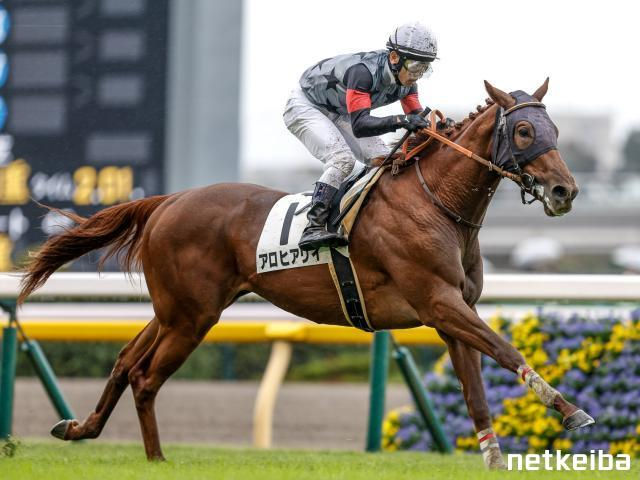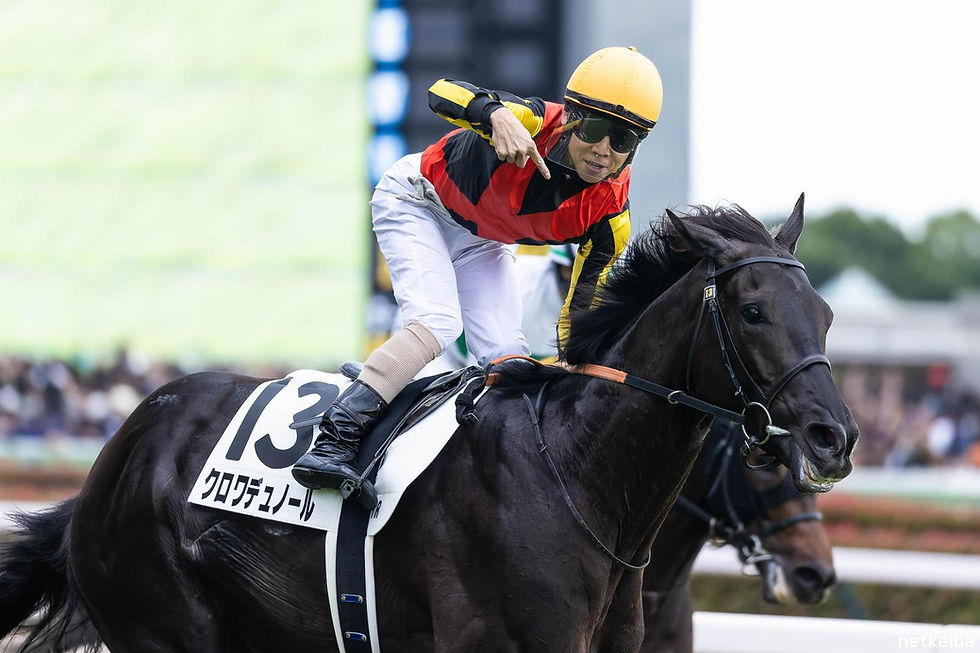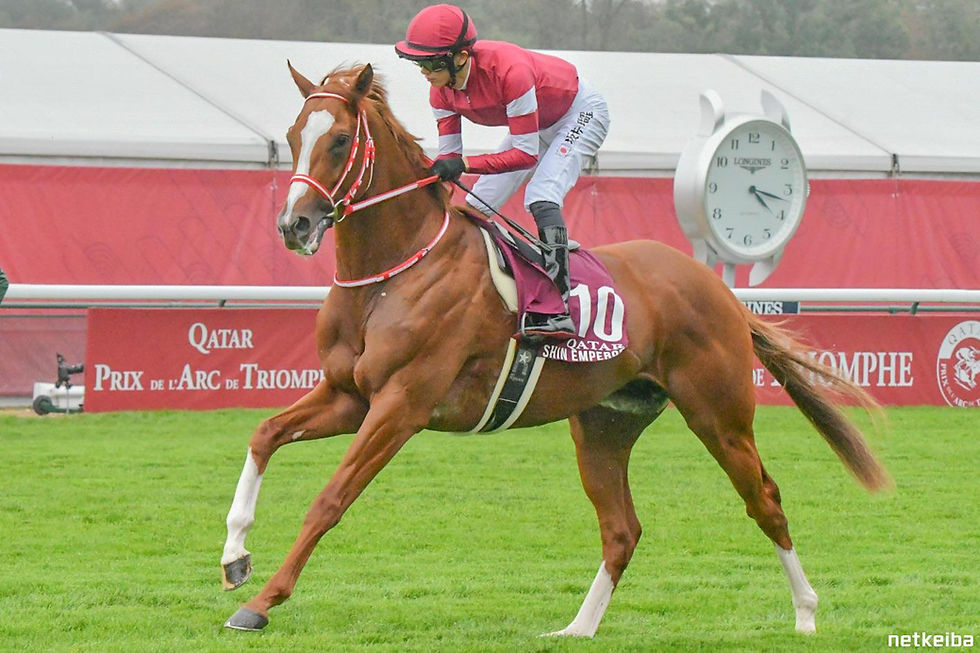Alohi Alii - Japanese Raider Spotlight
- Archie Brookes

- Aug 12
- 7 min read
Updated: Aug 21
Prix Guillaume d’Ornano (G2), 2000 m, 3yo — Deauville, Saturday 16 August 2025

Deauville assignment - overview
Alohi Alii heads to Deauville as Japan’s flag‑bearer for the Prix Guillaume d’Ornano, a race tailored to a 2,000m three‑year‑old still on the up. Lightly raced yet well credentialled, he blends Tokyo debut speed with Nakayama resilience, and he does so with Christophe Lemaire - a rider fluent in French race tempo - set to steer. Connections originally aimed at the Grand Prix de Paris but scratched on health/conditioning grounds, re‑routing to the d’Ornano while keeping an Arc entry live. He arrived in Chantilly on 28 July (20:47 local) after a ~31‑hour trip: a little edgy in transit, then settled and recovered once in the box. That timeline gives him roughly nineteen days to acclimatise - not extravagant, but coherent for a fit three‑year‑old who thrives on routine.
Alohi Alii is a chestnut colt foaled on the 18th January 2022, trained by Hiroyasu Tanaka at Miho for owner Tsuyoshi Suzuki and bred by Northern Farm. He was a ¥66,000,000 purchase at the 2022 Select Sale. His record is 4 starts: 1‑1‑1‑1 for ¥24.54m in earnings, all at 2,000m on turf. The Japanese data paints a consistent picture: he’s effective on good to soft with returns of 1‑0‑1‑0, and respectful on good at 0‑1‑0‑0. He has operated both left‑handed (Tokyo 1‑0‑0‑0) and right‑handed (Nakayama 0‑1‑1‑0). His running style is that of a closer/stalker - a hold‑up type who builds and sustains rather than relying on a single jab. Physically he looks to be holding condition while tightening with racing: 488 kg - 496 - 494 - 492 across his four starts.
Race-by-race form
He announced himself in a 2yo Newcomer at Tokyo (2000m, left-handed, “slightly soft”) on 2nd Nov 2024, sitting handy - positions 4-5-5 - and quickening best to win in 2:02.1. Sectionals framed the talent: race F3F 37.4 / L3F 34.7, with his L3F 34.3. He beat Divertissement by 2½L and showed a proper turn of foot down a long straight.
His first run of 2025 came in a 3yo 1-Win at Nakayama (2000m, right-handed, good) on 6th Jan. He tracked the pace - 6-6-7-4 - and closed in L3F 35.7 off a positive-split race shape (F3F 35.3 / L3F 36.8), just failing to reel in Go So Far; beaten ¾L in 2:00.8. As a first go around the tighter, turning course, it was a tidy effort that underlined tractability.
The step into Group company arrived in the G2 Hochi Hai Yayoi Sho (Deep Impact Kinen) at Nakayama (2000m, “slightly soft”) on 9 Mar. Ridden cold - 10-10-13-8 - he posted L3F 36.1 in a race run even-to-stamina-testing (F3F 35.9 / L3F 37.2). The winner Faust Rasen made all; Alohi Alii was the strongest of the closers, beaten only 0.1s in total (narrow necks). That was a bona fide Classic trial performance.
The G1 Satsuki Sho (Japanese 2000 Guineas), Nakayama, 20 Apr, was a deeper test. From last - 17-18 - he launched a bold mid-race move to 3rd/2nd around the final turns (17-18-3-2), then flattened late to finish 8th, beaten roughly 5 lengths, behind Museum Mile in 1:57.9. His L3F 35.5 versus the winner’s fast 34.1, in an evenly-run G1 (F3F 34.5 / L3F 34.8), suggests the mid-race aggression cost him a little at the finish - but it also proved he can carry speed into position against top company.
Zooming out, the trip looks nailed on at 2000m. He travels, can quicken, and tolerates different race shapes. He is untried beyond 2000m in public, but his pedigree and the barn's stated ambitions hint at stretching out later if results support it. Ground-wise, he is proven on good and good-to-soft; there is no evidence yet on proper soft/heavy, though nothing negative has shown so far. Visually, his Tokyo debut remains the cleanest piece; at Nakayama he has twice proved he can pass horses on the bend - no small feat there - including that audacious Satsuki mid-race surge. The lesson for connections is straightforward: use the turn to build, not to burn.
The Group 1 Satsuki Sho in April - hear the crowd cheer as Kazuo Yokoyama makes an audacious mid-race move aboard Alohi Alii
Why Deauville suits
The d’Ornano keeps him against his own age group and on a right-handed round course that won’t trouble a colt who corners cleanly and lengthens. Typical French summer going - anything from good to the soft side - ought to be fine based on what we’ve seen, with only properly soft ground raising a fresh question. Pace is the swing factor: an even-to-true gallop is ideal; a mid-race lull puts a premium on track craft, holding position, and sliding out early enough to avoid a pure dash.
Tactically, the baseline is simple: break cleanly, land fifth to eighth with cover, begin the move before the 500m, and present into the two-path by the 400m so he can stretch through the last 300m. Lemaire’s read of French patterns is a material asset. If leaders crawl, edge out sooner and turn the last 600m into an even build rather than a sprint he is unlikely to out-kick.
Course & pace dynamics
Deauville’s 2000m on the round course asks for balance into the turns and patience into the long straight. You don’t have to circle the field; you do need to be within range by the 500m and travelling. Races at this trip often feature a mid-race ease; when that happens, the winner is frequently the first to roll and sustain, not the last to launch. That script fits Alohi Alii’s strengths provided he isn’t buried on the rail.
Draws at this trip are less binary than at shorter distances, but the map still matters. A low stall can turn into a pocket if the pace backs off; a middle-to-outer draw can be ideal for a tractable stalker who accepts a lane wider on the bend to guarantee running room.
Pedigree and physical profile
Duramente contributes middle-distance class and efficient mechanics; Orfevre adds stamina, versatility and competitive instinct. The Duramente-Espoir (Orfevre) cross typically brings 10-12f pace with 2400m potential, which mirrors how he has been campaigned. From a Northern Farm family with a meaningful Select Sale ticket, he has the scope to lift to 2400m later; for now, ten furlongs is squarely his sweet spot. Physically he reads as an athletic, scopey colt whose action should not be compromised by a bit of give, provided the surface doesn’t turn holding.
Strategy
Trainer Hiroyasu Tanaka has based the colt at Chantilly to acclimatise, following a playbook that has served other Japanese ventures: ship in just under three weeks out, settle the horse, tighten locally with a European rider, and keep the routine simple. The strategy is clear - use a strong 10-furlong Group 2 restricted to three-year-olds as a springboard toward an Arc de Triomphe bid if the run confirms what the home form implies.
From a résumé standpoint, Alohi Alii arrives with stakes-level credentials - third in the G2 Yayoi Sho - Deep Impact Kinen by a whisker and eighth in the G1 Satsuki Sho/Japanese 2000 Guineas - all at 2000m. The Deauville test puts him straight against the best of Europe’s generation, typically including Prix du Jockey Club lines and high-rated improvers. For Japanese racing, a clean, competitive run would be a marker of intent: not merely turning up, but trading at the pointy end over a distance and on a track that showcase a sustained finish.
Opposition lens and draw/map scenarios (declarations pending)
Expect French Classic collateral, an unbeaten improver or two, and possibly a British miler stretching to ten furlongs. That mix can create a tempo puzzle: milers trying to stretch may steady mid-race; Derby types may force a truer gallop. Against either script, his best chance is to secure a lane before the sprint begins and to turn the last 600m into an even build. If the stall draw is low and the pace slackens, he needs to be one-off the fence before the elbow to avoid dead pockets. A middle draw with an even pace is the dream map - land behind the speed pair, keep the back straight smooth, commit before the elbow. Drawn wide into a true gallop, he can accept a lane deeper early to avoid check-ups, draft on the turn, and roll uninterrupted.
Risks and unknowns
Two questions hover: how much acclimatisation he has achieved in a ~19-day window, and what race shape he draws. France can turn cagey; being too far back into a slow middle can blunt his grind. He is still a four-start colt meeting battle-hardened peers. The mitigants are clear: tractability, a rider who anticipates those patterns, and a run style that is robust to variance provided he isn’t locked away.
What a top-three would mean
A placing would validate the 2000m platform at European Group 2 level and keep the Arc pathway live on merit, not just optimism. It would also raise his ceiling for autumn targets - a 10f/12f decision depending on how he finishes the last 200m at Deauville. For the broader Japanese programme, it would add another data point that the sustained-finish profile transports well to French tempo and configuration.
Betting view
He reads like an each-way bet at the right price if the market over-weights French Classic lines. Value hinges on draw, going, and final field. The in-running tell is simple: if he finds the two-path by the 400 m with something to chase, he stays on; if it turns into a crawl and he’s buried, his edge narrows. True soft is the caution flag.
Verdict
Alohi Alii is a credible Guillaume d’Ornano player: proven at 2000m, equipped with a sustained finish, and guided by Lemaire. If he handles the travel and the race isn’t a crawl, he’s a frame contender - with upside.
Enjoyed this piece?
If this spotlight helped, please consider giving it a share and follow me on X
for more Japanese racing coverage, sectionals, and betting angles. You can also check archiebrookesracing.net for the latest spotlights and race-day notes. Cheers for reading.



Comments